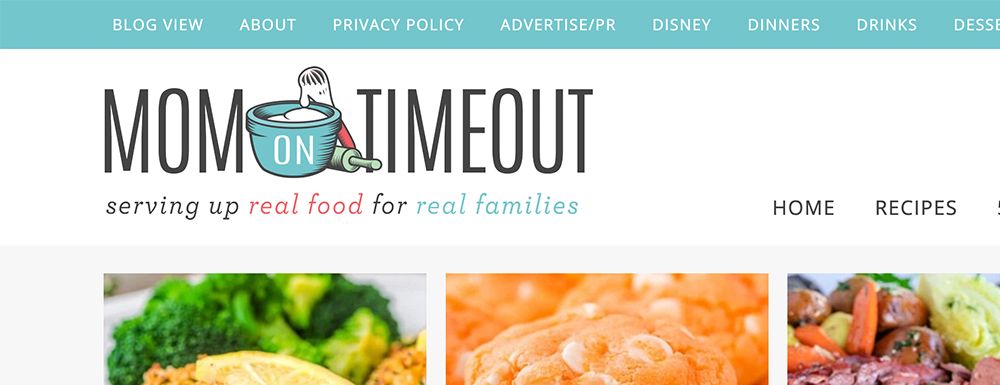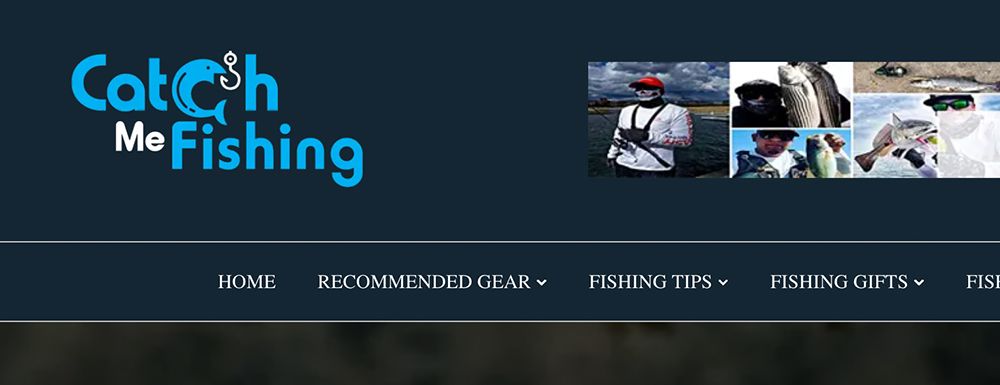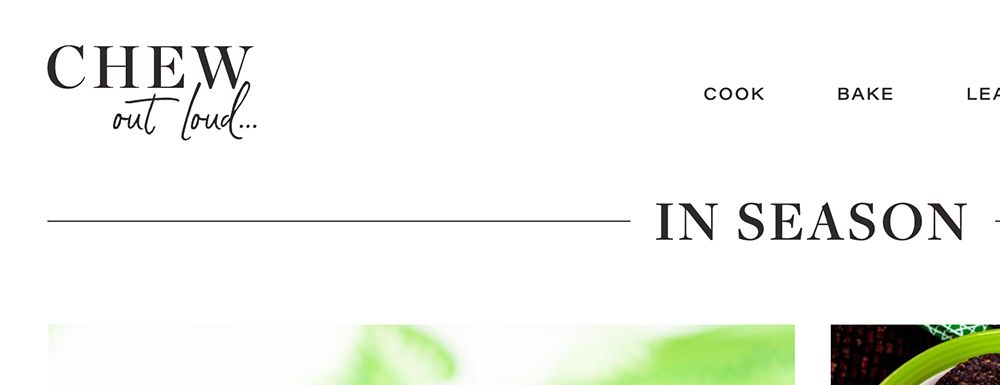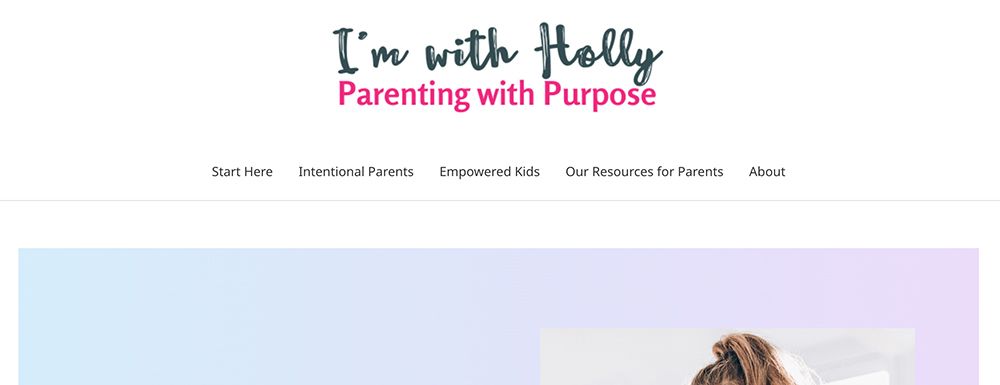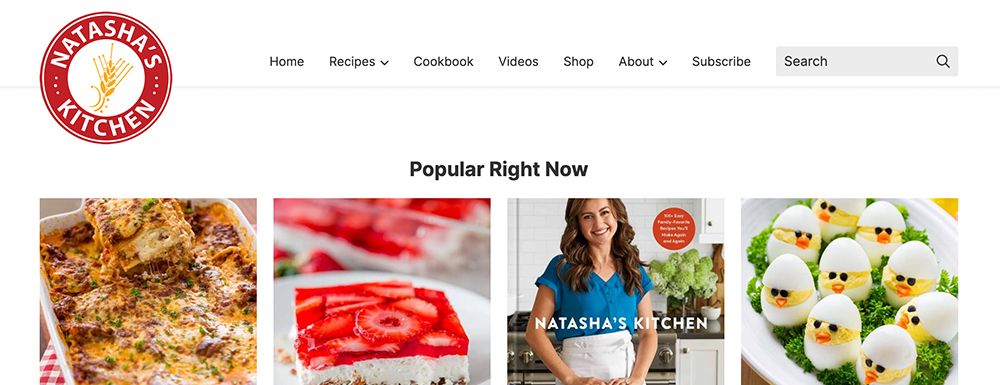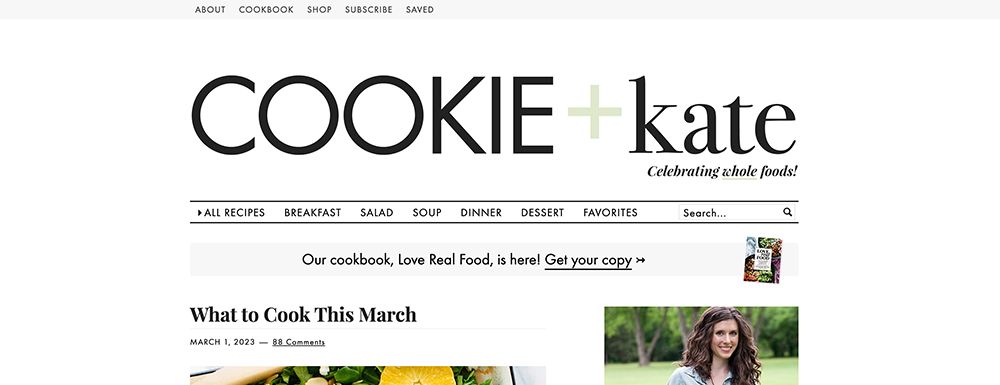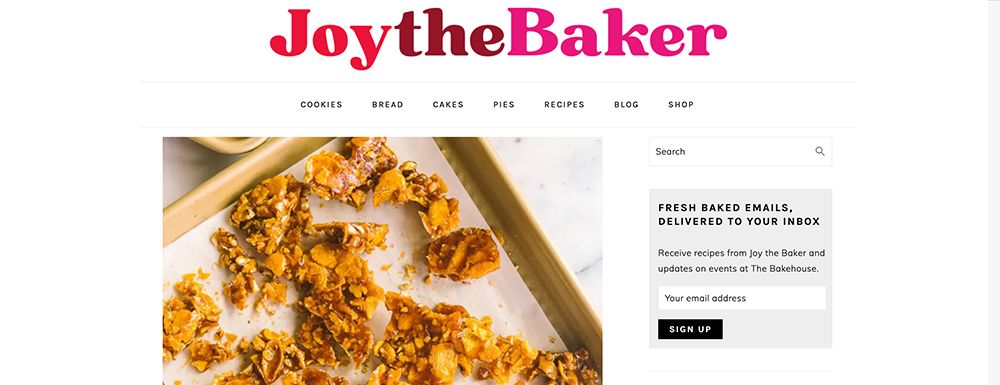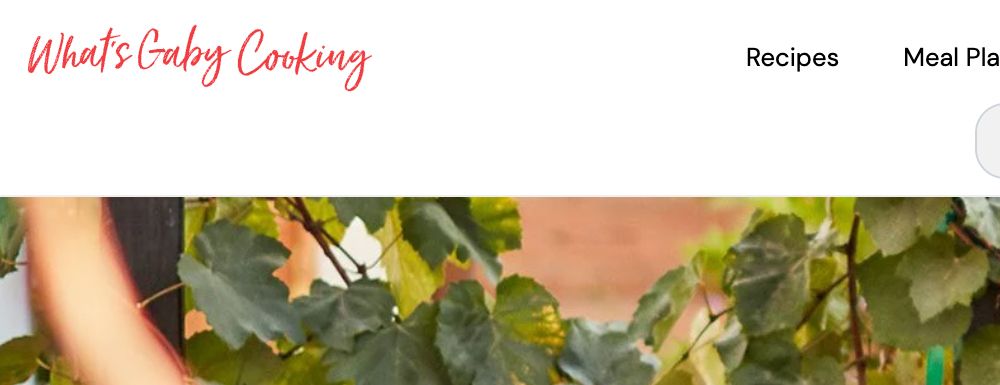The Blog Name Playbook: Data and Strategies From Analyzing 1,217 Blogs

Dave Ver Meer · Updated: July 24, 2023

We analyzed 1,217 blogs to uncover the techniques, tactics, and strategies used to name blogs.
In this post, we reveal what makes blog names tick, compare naming across niches, and share examples from our study.
The main criteria we used when gathering blogs for the study were no mega blogs that have huge teams and no company blogs.
The study covers 12 popular niches, and they’re evenly represented in the data.
Content
Let’s start with some key findings and stats.
Key findings and statistics
-
Our data shows that 23% of blog names flip the script, making it the most used technique. At 18%, alliteration comes in a close second.
-
7% of blog names use a play on words and only 3% use rhyming.
-
The vast majority of blog names (80%) include keywords related to their niche. Of the 20% that don’t, most rely on the Moniker and Story tactics instead.
-
When keywords are used in a blog name, 93% use one keyword, 6% use two, and 1% use three.
-
We discovered that 42% of blog names use the Story tactic. At 60%, Mom & Parenting and Travel, are tied for the highest usage rate.
-
We found that 17% of blog names use the Moniker tactic. 9% of bloggers use both their first and last names together.
-
Our analysis shows that 33% of blog names use The Signature Strategy. Travel blogs have the highest rate of using it, at 51%.
-
Only 3% of blog names use The Beanstalk Strategy. Which makes sense given that a lower percentage of blogs use the Moniker tactic (17%) to begin with.
-
We found that 7% of blog names use The Guru Strategy, which helps make a personal connection and position them as an authority on a topic at the same time.
-
The rarest strategy used is The Unicorn Strategy (2%). Travel is at least 4 times more likely to use it than all other niches.
-
When we broke the names down, we found that 43% use three words, 39% use two words, and 15% use four or more. Only 3% are one-word.
-
36% of blogs have a tagline. They either use it to help explain what the blog is about or talk about their mission.
-
Not including the Blogging niche, only 4% of blog names use the word “blog” and its variations in the name.
Techniques to power-up your blog name
There are many techniques that can be used when naming, and while this isn’t an exhaustive list, it covers the most important ones we found in our analysis.
Flip The Script
This first technique focuses on approaching the name from an unexpected angle. Or it uses words that aren’t related to the blog’s topic.
The advantages you get with this technique are making the name memorable and helping it stand out from other blogs. Flipping the script can also be used to hint at a specific point of view, the personality of your blog, and the writing style.
23% of blog names flip the script, making it the most used technique in our study.
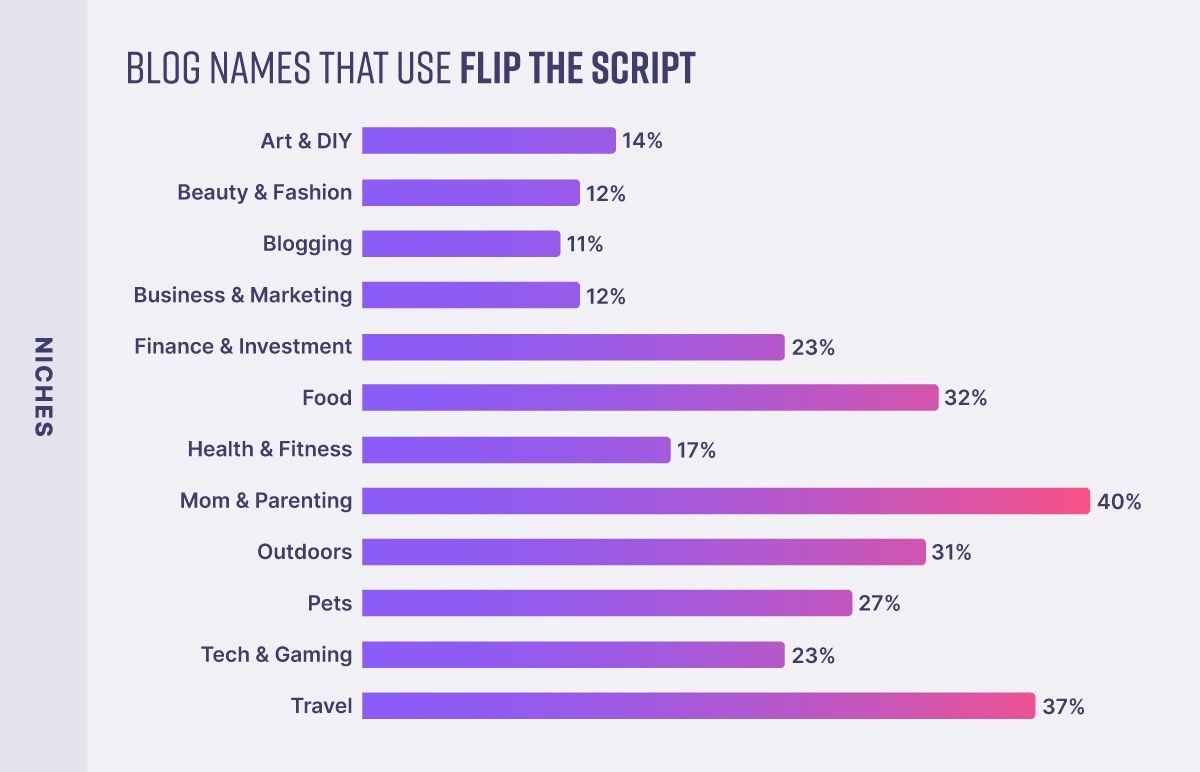
Here are some examples of it in action:
- Rage Against The Minivan
- Runs For Cookies
- Growth Badger
- OkDork
- My Wife Quit Her Job
- Gnome Stew
- Detailed
- Financial Panther
- Pinch Of Yum
- Rock Paper Shotgun
Play On Words
A play on words is exactly what it sounds like. It can be any type of humor, including sarcasm and puns.
You could also say that it’s a cousin to flipping the script. Its key advantages are that it excels at lightening the mood and forming an instant connection.
In fact, when given a choice between brands, 72% of people would choose a humorous one.
7% of blog names use a play on words. We saw very little sarcasm, and puns are only used by 1%.
Not counting Beauty & Fashion and Food, the Pets niche is at least 2 times more likely to use it than others.
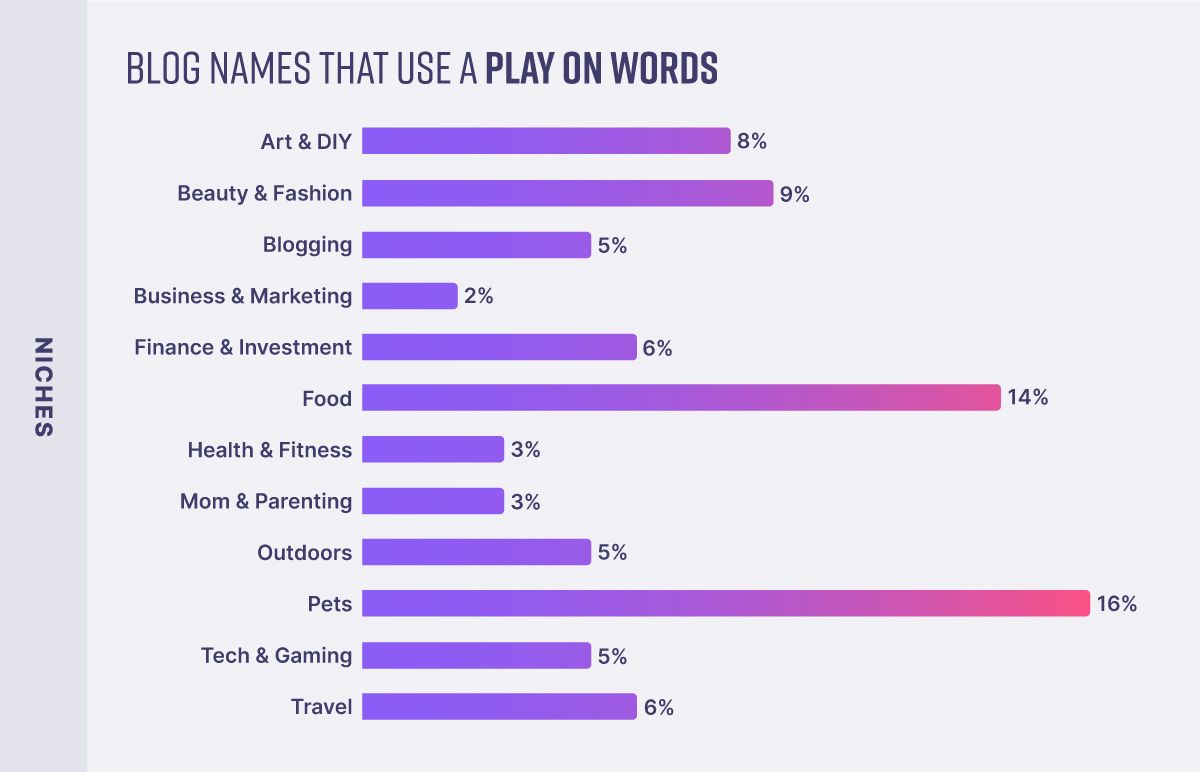
Let’s take a look at a few:
- Gimme Some Oven
- Shed Happens
- She Means Blogging
- Repeat Crafter Me
- Budget Bytes
- Pawsitively Intrepid
- Cool Of The Wild
- Pregnant Chicken
Alliteration
By definition, alliteration is the repetition of an initial consonant in a group of words that are close to each other.
In other words, they start with the same letter. They’re often back-to-back, but they don’t have to be.
Alliteration creates a natural rhythm and sounds better. It also helps people remember the name.
Surprisingly, at 18%, alliteration isn’t the most used technique in our study. Given how flexible and relatively easy it is to use, we thought it would be the highest.
We also found that 29% of Food blogs use alliteration, which is the highest among the niches. Business & Marketing and Tech & Gaming are tied for the lowest, at 12%.
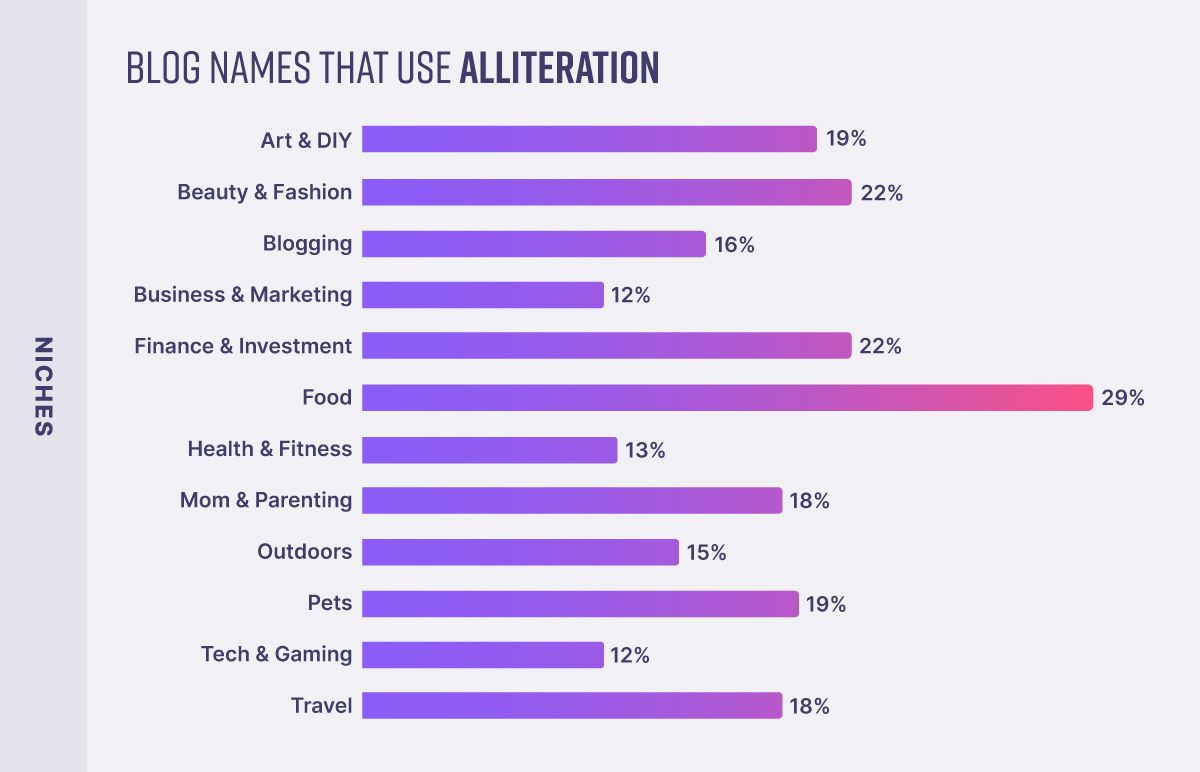
Here are some examples:
- A Girl And A Glue Gun
- Pickled Plum
- Believe In A Budget
- Family Focus Blog
- Monkeys And Mountains
- Six Sisters' Stuff
- Color Me Courtney
- Well Kept Wallet
Maybe you want to include your first name, and it happens to start with the same letter as a keyword related to your blog’s niche. Like Sydne Style does.
Or you could add related adjectives and nouns, like Fit Foodie Finds.
Rhyming
Rhymes come in different forms, but in general, it’s when the ending of words sound the same. No Meat Athlete and The Cookie Rookie are prime examples.
Like alliteration, rhyming words are often back-to-back, but they don’t have to be.
Rhyming also improves the flow of a blog name and helps it stick in your head.
Only 3% of blog names use rhyming, which is lower than we expected. But it makes sense when you think about the added difficulty in coming up with a rhyme that fits.
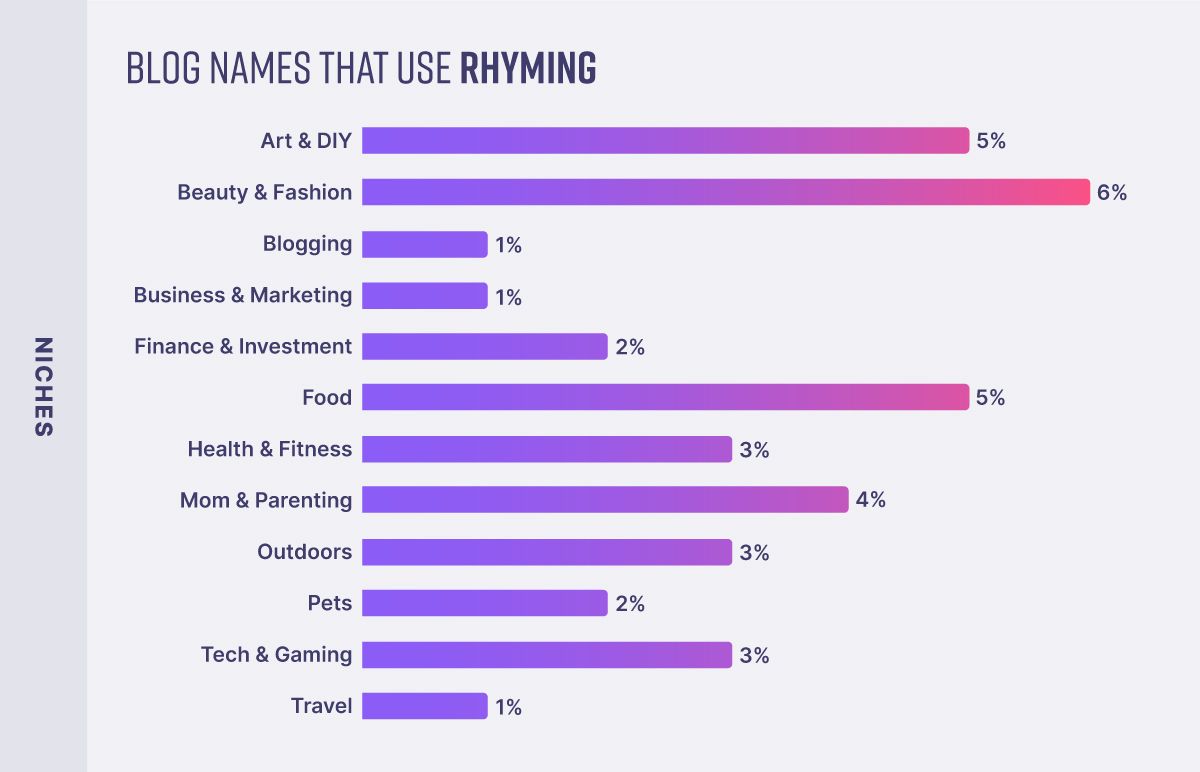
We picked out some examples to help inspire you:
- Fashion Jackson
- Smitten Kitchen
- Grown & Flown
- Ohoh Deco
- Run Eat Repeat
- The Cheese Knees
- Geeky Sweetie
Combo moves 🎮
To give you an idea of what’s possible, we want to point out that some bloggers use more than one technique to take things up a notch. Although, it does get progressively harder to pull off with each technique you add.
In combos, usually two techniques are used. Some combos, like a play on words and flipping the script, naturally work well together. Alliteration combines well with any of the other techniques.
That said, here are some examples:
- Live And Let Hike (Alliteration | Play On Words)
- Two Peas & Their Pod (Alliteration | Play On Words | Flip The Script)
- Making Sense Of Cents (Rhyming | Play On Words)
- The Honeycomb Home (Alliteration | Rhyming)
Key takeaways:
-
Think of techniques as force multipliers. They amplify how effective a blog name is and pack a punch in terms of grabbing your audience’s attention and making the name memorable.
-
Alliteration lends itself to working for any type of blog name, is easy to use, and helps people remember the name.
-
Rhyming is the least used and is harder to use than others. But it can still be helpful if you find a rhyme that’s a good fit.
-
Using a play on words or flipping the script can give your blog personality and form a connection with your readers.
Tactics and strategies you can steal for your game plan
Now let’s take a look at names from a higher level that factors in things like marketing and branding.
Almost all blog names use one or more of the following tactics in their strategy:
-
A story that sparks your interest
-
Keywords that signal what a blog is about
-
The blogger’s moniker to help make a personal connection
They’re all powerful on their own and even more so when combined in a strategy. Many of the examples we’ll share also use the techniques we just covered.
Story Tactic
When used in the context of a blog name, a story is useful as a conversation starter and icebreaker.
Put another way: it’s the opening line and beginning of a narrative that unfolds through posts on your blog.
Storytelling also helps build a deeper connection with your readers and create a shared experience.
In fact, our brains love storytelling and release chemicals, like oxytocin, that make information persuasive and memorable.
We found that 42% of blogs use the Story tactic. Some are more open-ended, as in She Dreams All Day, while others like The Girl Who Ate Everything focus more on the blog’s topic.
Mystery, humor, and even shock can be used as the basis for a story. And like any compelling story, it’s the sum of the words in a blog name that brings it to life.
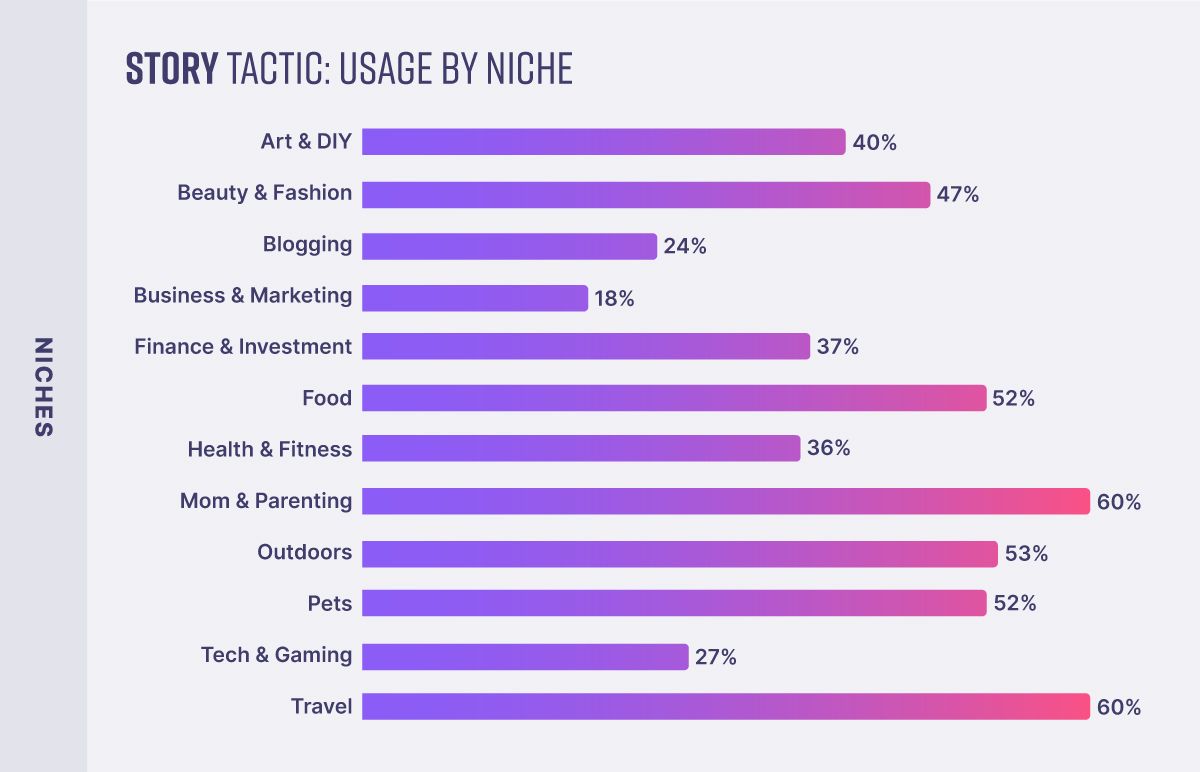
Take a look at the variety of ways a story can be started:
- Salt In Our Hair
- One Hundred Dollars A Month
- Location Rebel
- Mum In The Mad House
- I Like To Dabble
- An Indigo Day
- Champion Of My Heart
- Pint Sized Treasures
- Living In Yellow
- Two Wandering Soles
Keywords Tactic
While they’re not as attention grabbing as other tactics on their own, keywords make up the “bread and butter” of most names. They also give a solid base to build around.
In fact, as we’ll show later, keywords can be fused with other tactics to take advantage of their strengths.
We defined a keyword as one that has anywhere from a weak to strong relationship with a blog’s niche. Most of the time, the keywords used are directly related.
A whopping 80% of blogs use the Keywords tactic. We were surprised that 20% don’t use any keywords, as that’s a decent portion. Of those that don’t, most focus on the Moniker and Story tactics instead.
Keywords are often paired with adjectives, like Smart Blogger, or verbs, like Master Blogging. Smart Blogger’s post on power words has a treasure trove of them that you can help yourself to.
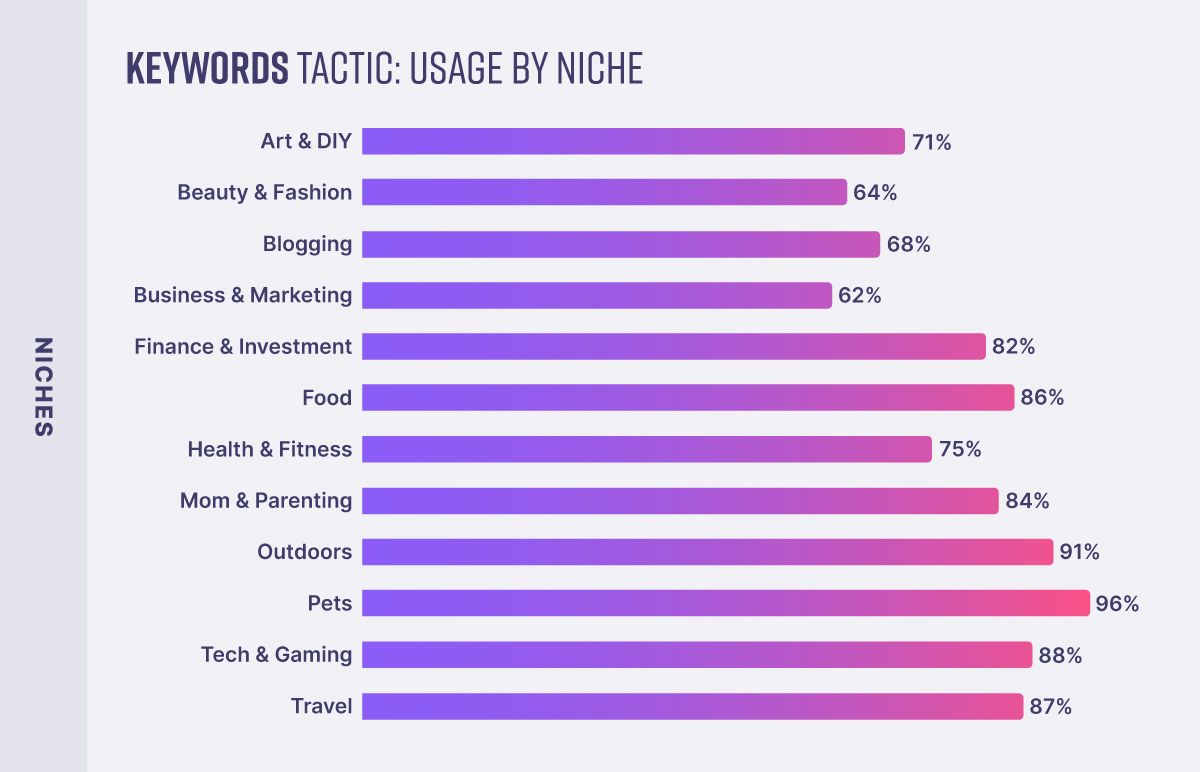
With that in mind, here are some examples:
- Side Hustle Nation
- Backlinko
- Best Wallet Hacks
- Mostly Blogging
- Cat And Dog Chat With Caren
- Retro Dodo
- Blogging Wizard
- The Franchise King
- Blogging Tips
- Paper & Stitch
- Wolf's Gaming Blog
We also observed that a dip in keywords use for a niche tends to correspond with higher moniker use. Since a keyword is rarely included when a blogger uses their first and last name together.
Of the blog names that do use keywords, 93% use one keyword. Followed by 6% that use two, and 1% that use three.
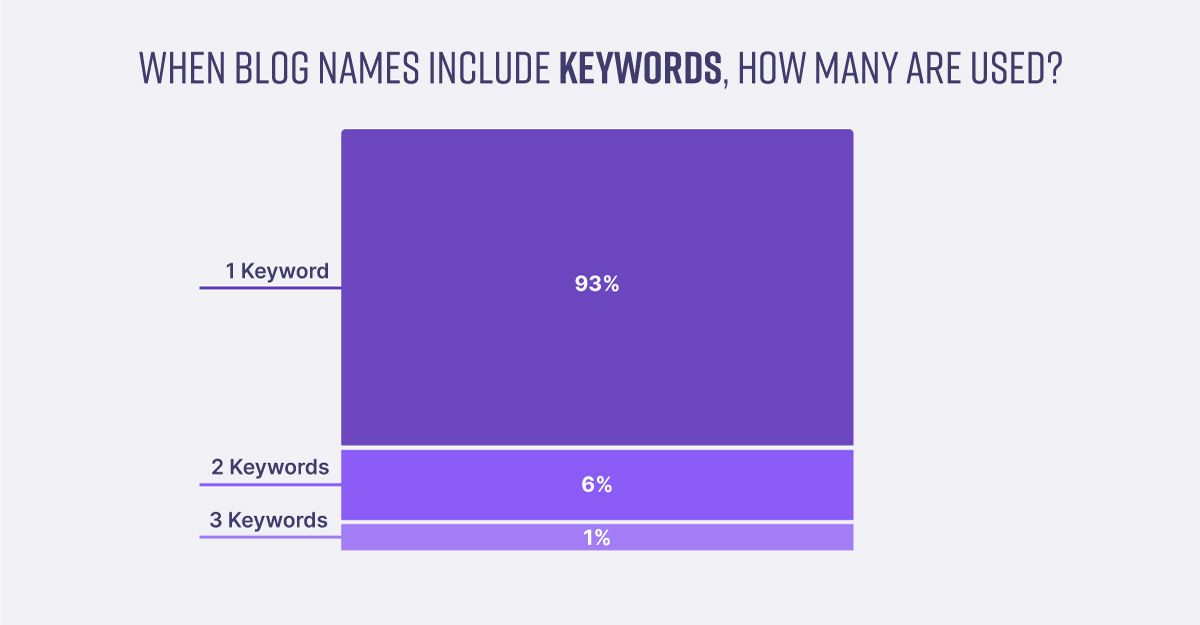
Moniker Tactic
A common question that’s asked is: “Should I name my blog after myself?”. It’s a key decision you might need to make.
There’s a special kind of vulnerability, ownership, and authenticity that comes with linking your blog to your own name. A moniker can be a nickname, a first and/or last name, or some other alias that people know someone by.
We found that 17% of bloggers use a moniker in some form. 16% of bloggers use their first name, and 10% use their last.
9% of bloggers use both their first and last names together. In those cases, it’s rare for the names to include other words besides the moniker. When they do, it's usually a single keyword.
Its usage varies widely among the niches. The highest and lowest are:
-
Beauty & Fashion (31%)
-
Health & Fitness (29%)
-
Business & Marketing (28%)
-
Finance & Investment (6%)
-
Mom & Parenting (6%)
-
Pets (3%)
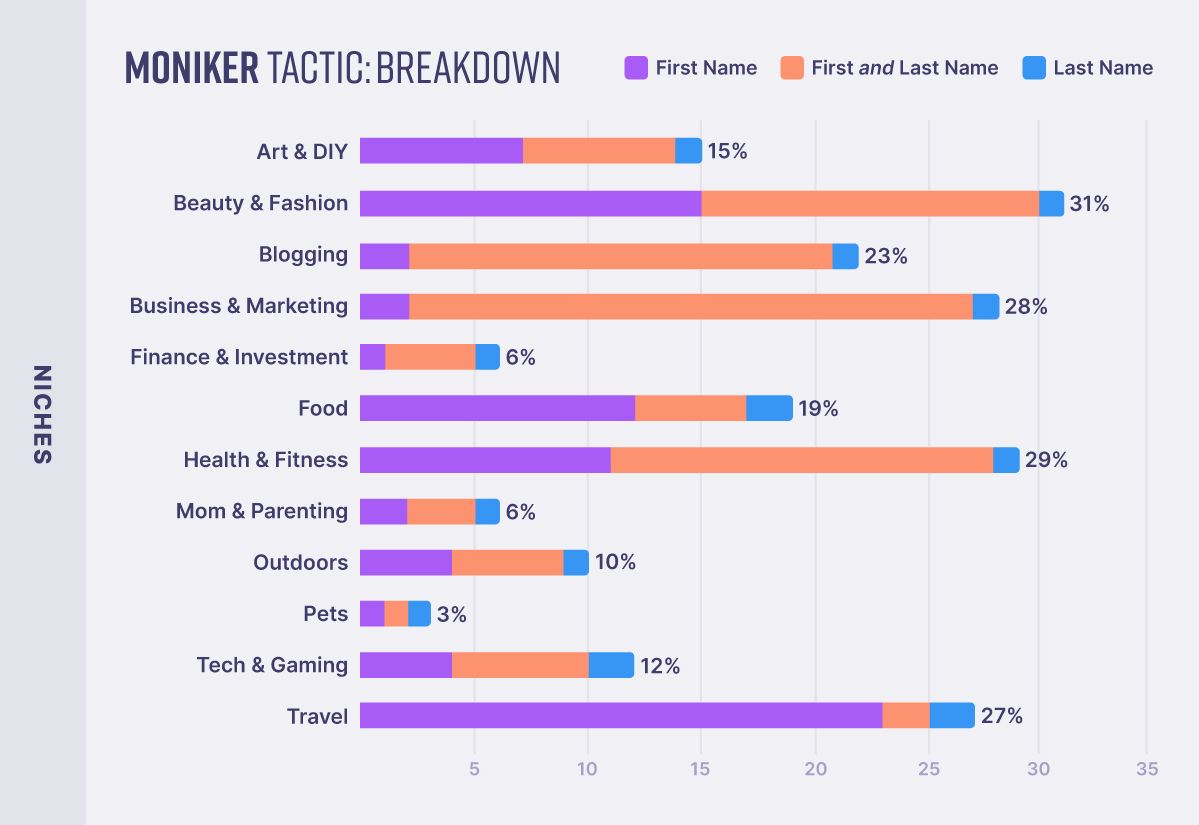
Take these for example:
- The Planet D
- Ryan Robinson
- By Sophia Lee
- Neal Schaffer
- Ask Chef Dennis
- Rob Powell Biz Blog
- Larry Ludwig
- Dong Knows Tech
- Xpat Matt
We also found a correlation where niches that offer services and products on their blog are more likely to use a moniker.
The Signature Strategy ✍🏻
This strategy is super powerful because the team-up uses the Story tactic as a compelling hook, and the Keywords tactic tells what your blog is about. They work together to create a signature story that only you can tell.
Niches that are more focused on lifestyle will naturally benefit from using it.
33% of blogs use The Signature Strategy. Travel blogs have the highest rate of using this strategy, at 51%, while Business & Marketing have the lowest, at 10%.
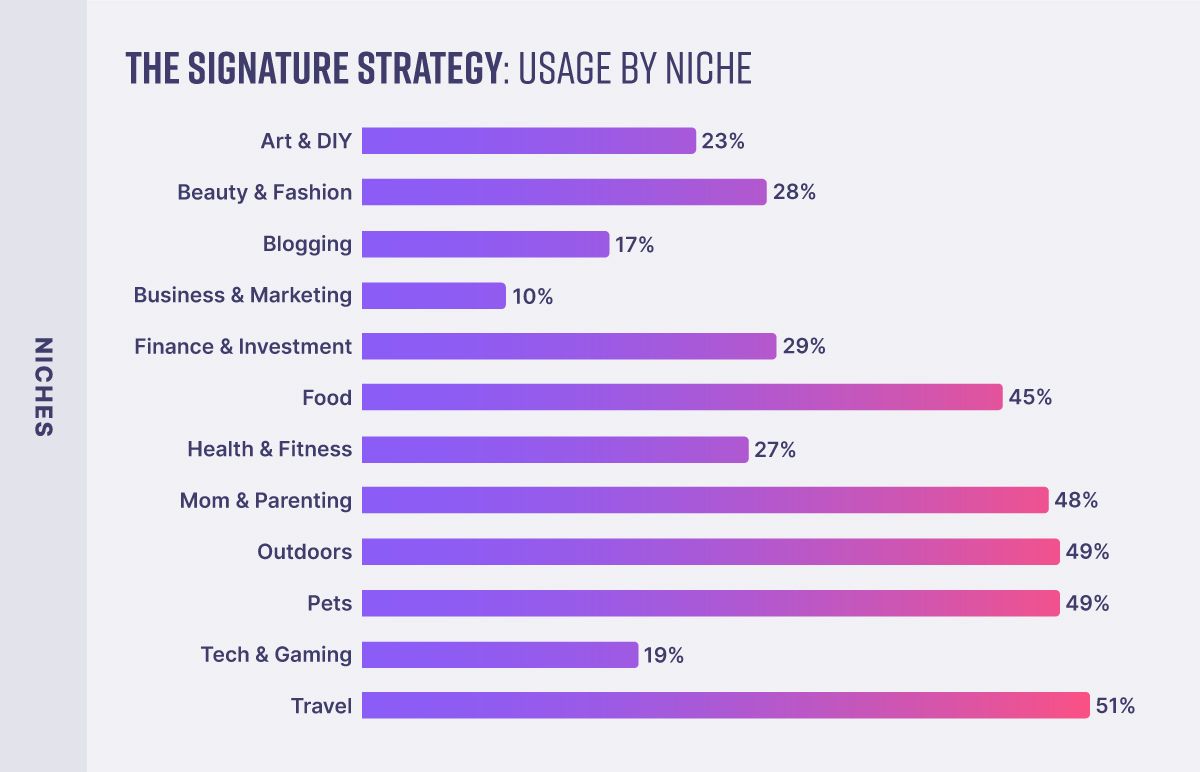
Let’s take a look at a few:
The Beanstalk Strategy 🫘
With this strategy, you cast yourself in the leading role of the story, like the tale “Jack and the Beanstalk” does. To do that, it uses the Moniker and Story tactics together.
It’s a winning strategy for those who want to be directly associated with their blog and also draw readers in with the story.
Only 3% of blogs use The Beanstalk Strategy. Which makes sense given that a lower percentage of blogs use the Moniker tactic (17%) to begin with.
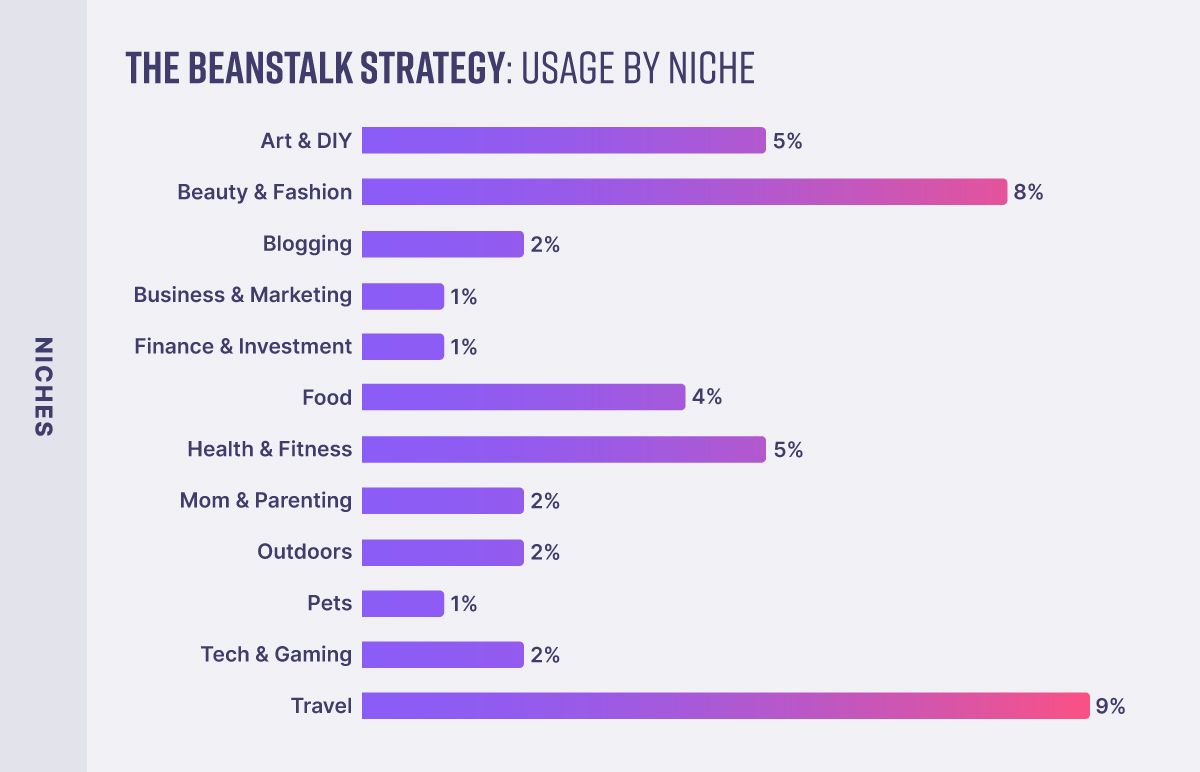
Here are a few examples:
The Guru Strategy 🤓
We found that 7% of blogs use The Guru Strategy, combining the Keywords and Moniker tactics. When you adopt this strategy, you’re positioning yourself as an authority and expert in a niche.
In fact, the ultimate goal is that when someone thinks of a topic, they think of you.
Another key advantage is being able to make a personal connection, while still telling your audience what your blog is about at the same time.
The niches with the highest and lowest use of The Guru Strategy are:
-
Travel (21%)
-
Health & Fitness (15%)
-
Food (12%)
-
Finance & Investment (2%)
-
Mom & Parenting (1%)
-
Pets (1%)
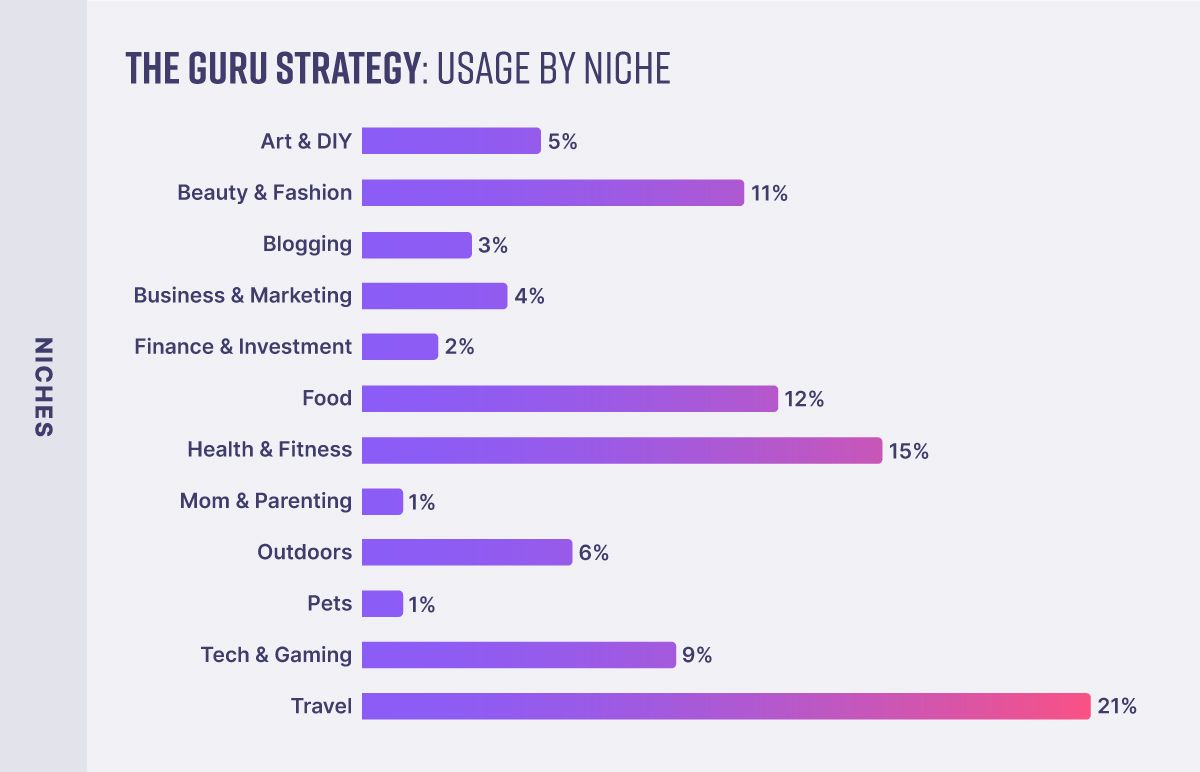
For some ideas, consider how these blogs use this strategy:
The Unicorn Strategy 🦄
Only 2% of blogs use The Unicorn Strategy, making it the rarest. It combines the strengths of all three tactics: Story, Keywords, and Moniker.
Coming up with a name that uses all of them is tough, but the extra time spent can pay off.
The Travel niche leads the pack here, with the highest usage at 8%. All others are 1 or 2%, making Travel at least 4 times more likely to use this strategy than other niches.
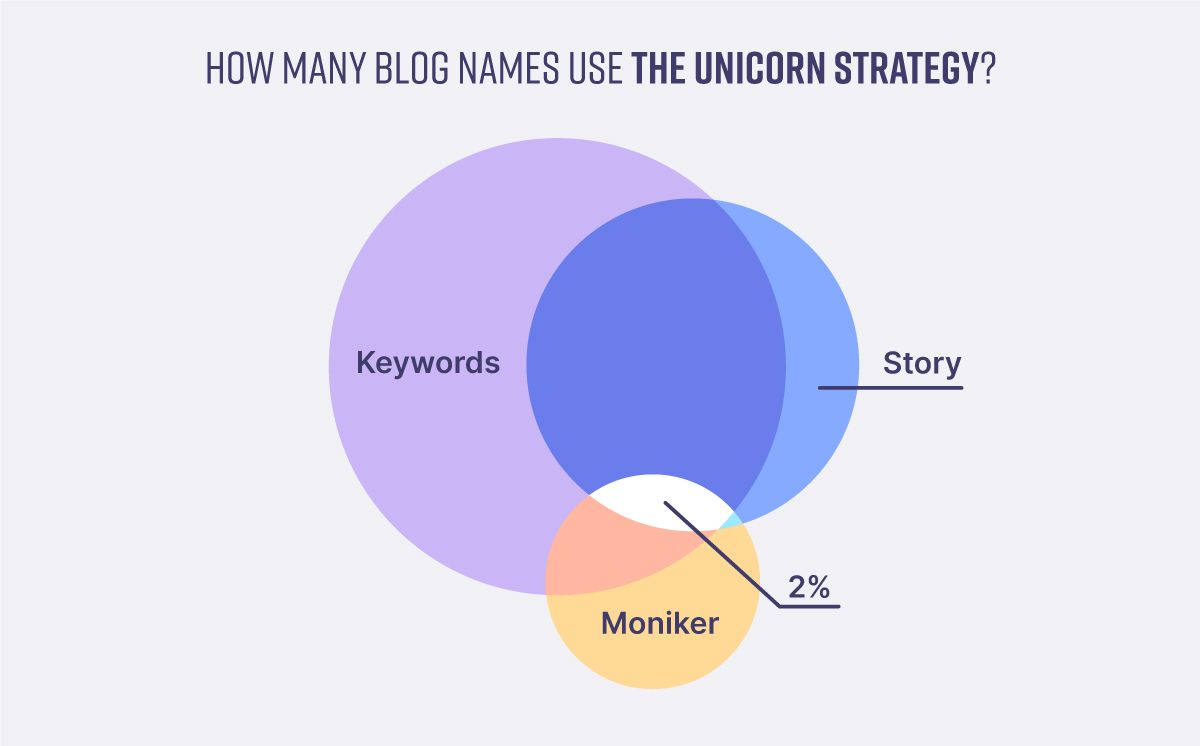
Here are some examples:
Key takeaways
-
Each tactic by itself is special, so don’t feel like you have to use more than one. When considering strategies, you should explore ones that match your goals.
-
When your blog name is the opening line of a story, it attracts your reader’s attention and creates a shared experience.
-
Niches that are lifestyle-oriented make use of stories more often, while niches that are business-focused tend to lean into keywords.
-
Use keywords to tell people what the topic of your blog is. But don’t get carried away. Overloading it with keywords can feel forced and unnatural.
Only a small fraction of blogs have “blog” in their name
We found that 4% of blog names use the word “blog” and its variations (“blogs”, “blogger” and “blogging”) in the name*.
And it's no surprise, that of all niches, Blogging has the highest rate (55%). Blogging is at least 6.9 times more likely to use “blog” in the name than all other niches.
*The Blogging niche was excluded from the overall rate since they represent a large percentage of names using “blog” and it would skew the data.
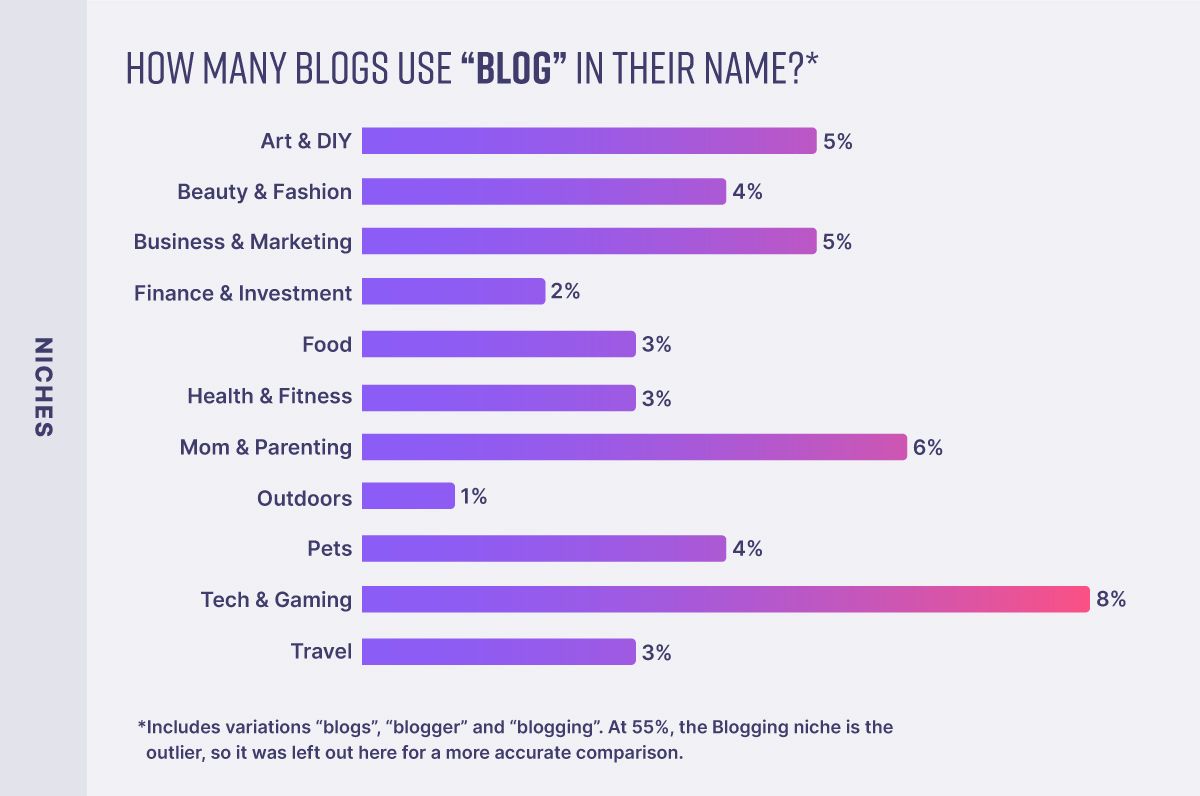
Key takeaway
Don’t worry about including “blog” or its variations in your name, unless your blog is about blogging and it makes sense to include it as a keyword.
Taglines are used by a healthy number of blogs
Early on in the study, it was clear that taglines play a role in supporting the name. So we decided the study wouldn’t be complete without mentioning them.
We defined a tagline as a phrase or sentence that’s either part of the logo or located very close to it.
You might call them slogans or mottos, but for the purposes of the study, we’re referring to them all as taglines.
36% of blogs have a tagline, with Mom & Parenting having the highest (52%), and Blogging the lowest (17%).
It should be noted that the Blogging niche often uses the main heading on the blog homepage for the same purpose, as do some other niches. Which helps explain the lower percentages for some.
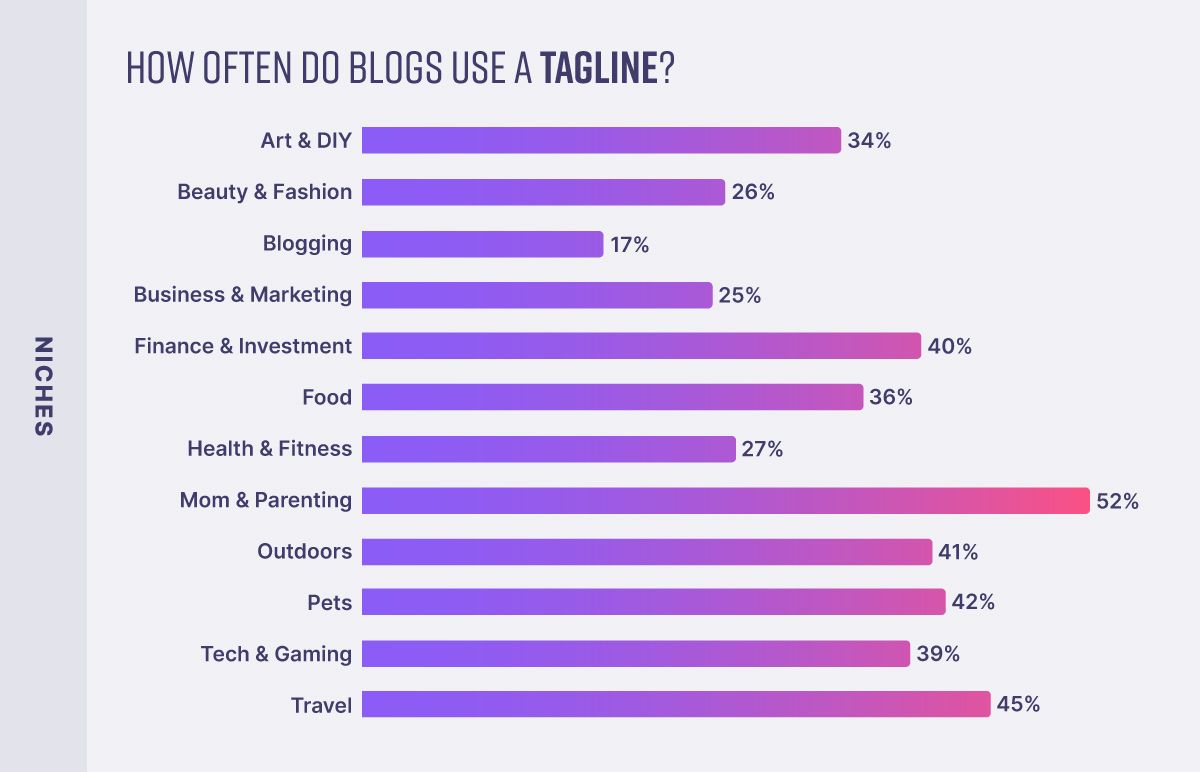
Some taglines help clarify what the blog is about, while others talk about the mission and are more aspirational.
Take these for example:
-
“Personal finance from the broke perspective.” (Beating Broke)
-
“A food blog with fresh, zesty recipes.” (Love & Lemons)
-
“The life of a girl who loves apples and running.” (Anna The Apple)
-
“The world's premier hunting and fishing blog.” (Morning Moss)
-
“Live. Laugh. Loaf.” (Kitty Loaf)
-
“A rich life on a minimum wage.” (Penniless Parenting)
Key takeaway
Taglines are useful for expanding on what a blog is about. Even more so when a name doesn’t make a clear connection with the blog’s topic.
Most blogs use three or more words in their name
When we broke the names down, it showed that the number of words they’re made up of is: three words (43%), two words (39%), and four or more (15%).
Only 3% of blog names are made up of one word, with the highest percentage of one-word names being in Tech & Gaming (9%).
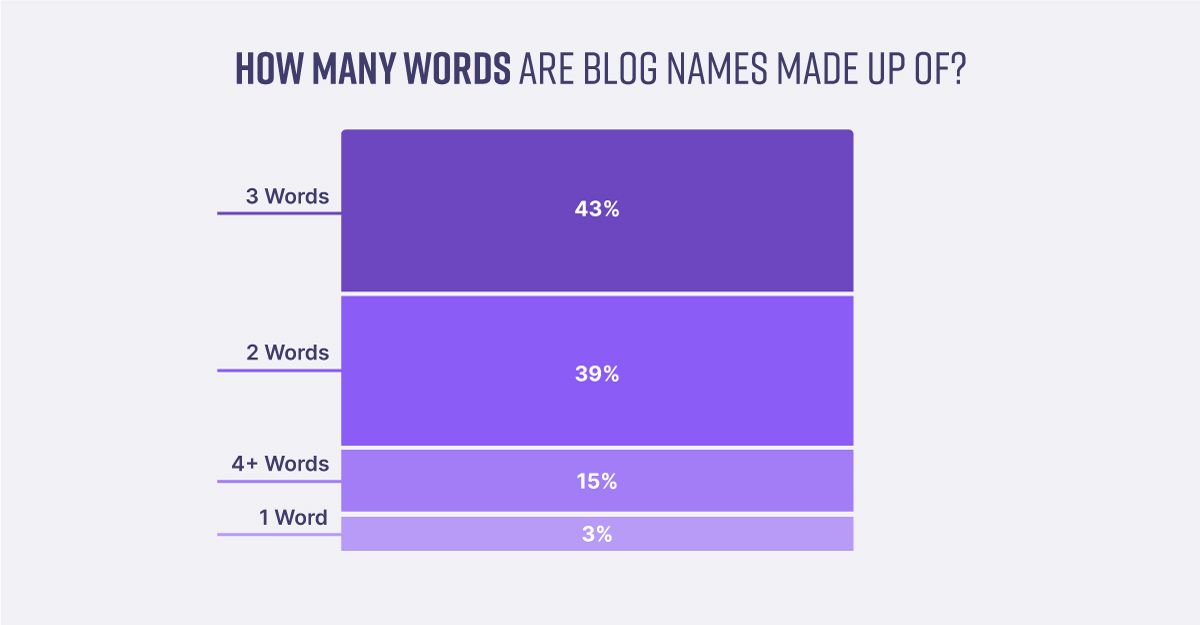
Try not to fixate too much on the length when coming up with your blog name. If you want one that’s longer, you can work in some of the techniques and strategies covered earlier to boost recall and recognition.
Key takeaway
Blog names that are three or more words long make up a combined 58%, so it’s OK if your name is on the longer side. Just make the words count and add value.
Bonus stats and infographic
-
3% of blogs use numbers in their name. If you want to use a number in your name, keep in mind that it could cause some confusion with how it's spelled and used in your name.
-
10% of blog names start with “The”. It can help communicate that the blog is the definitive source of info on a topic. Or it could simply have been added because the domain wasn’t available to register without it.
-
We found that the average length of blog domain names is 14 characters. Which is a little longer than the average length of 10 for the top million most popular websites.

Conclusion
We were blown away by how many amazing blog names there are. There were far too many to all list in this post, though we wish we could have.
We encourage you to not start out with a rigid plan or twist your name into a pretzel trying to get it to fit in a specific set of boxes.
Instead, think about which techniques and strategies fit your niche and personality the best. Then do some experimenting and exploration with those.
The journey of naming often takes you to unexpected places, and you may end up with a name that surprises you.
At the end of the day, you’re the only one who can answer what name is right for you and your blog.
Study details and criteria
We conducted the study by analyzing 1,217 blogs. To ensure a healthy, representative mix ranging from well-established to up-and-coming blogs, we dove deep into Google results to find ones that met our criteria in each niche.
Google decides what shows up in results based on its algorithm, so it's more predictable and impartial than if we had looked for blogs in best-of or roundup posts that were curated by someone.
We also gathered twice the number of blogs we wanted for our final sample size. Then we ran the lists through a random selector to cut them in half and end up with the blogs to include in the study.
Since the blog names didn’t always match up with the domain name, we looked at the logo for the official name to analyze.
Most blogs focused on a single topic, but some covered multiple. In those cases, we reviewed their top and most recent posts for topic frequency to decide which niche to place them in.
As for criteria, they needed to be:
-
Small to large blogs. No company blogs and no mega blogs.
-
Active, by either publishing or updating posts within the past year.
Niches
The study covers 12 popular niches and we examined each niche individually by segmenting them. So for the data that's specific to a niche, it’s comparing just the blogs within that niche to each other.
-
Art & DIY
-
Beauty & Fashion
-
Blogging
-
Business & Marketing
-
Finance & Investment
-
Food
-
Health & Fitness
-
Mom & Parenting
-
Outdoors
-
Pets
-
Tech & Gaming
-
Travel
